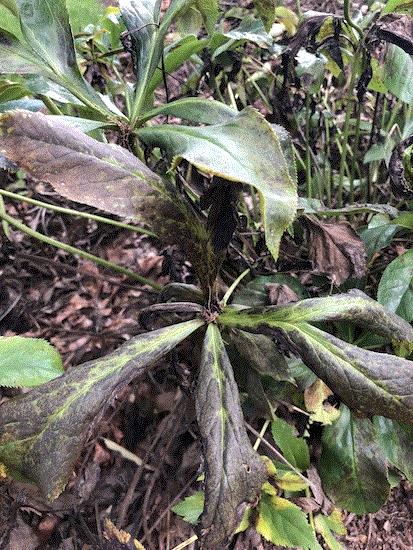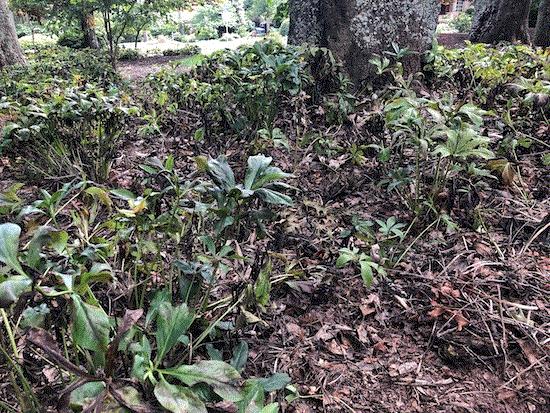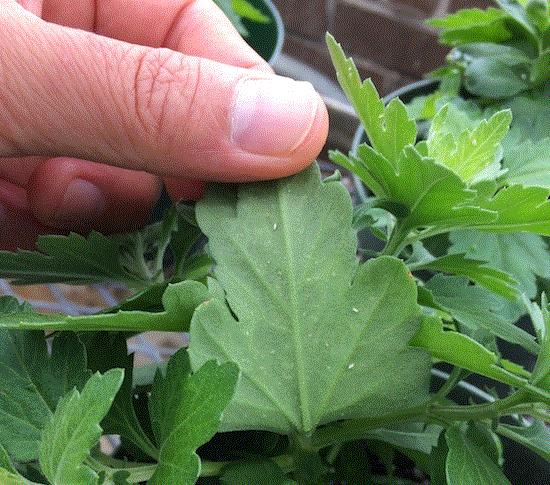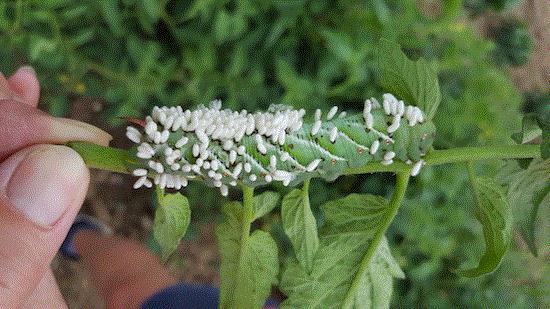Downy mildew on hellebores
Hellebores, or the lenten rose, is a beloved, late-winter and early spring bloomer. Their tight clusters of bell-shaped flowers add colors to the otherwise drab late-winter landscape.
Hellebores are relatively low maintenance and do quite well under shade and in well-drained soil. It's generally pest- and disease-free, but reports of hellebores infested by downy mildew are surfacing more frequently in recent years. Cory Tanner of Clemson University Extension Service in Greenville, South Carolina, forwarded me a report and a couple of pictures.


Hellebores downy mildew can cause speckles and lesions on leaves and flowers, and can ravaged the planting over time. (Photo courtesy of Scott Carlson of Schneider Tree Care.)
The causal agent of downy mildew on hellebores is Peronospora pulveracea. Colleen Warfield, now with Ball Horticultural Company, reported on this disease infecting hellebores in San Mateo County, California, in 2008. However, the disease was already detected in Georgia in 2007. There's not a good account of the disease's current distribution. I suggest anyone with hellebores to watch out for the disease.
Hellebores downy mildew causes brown to black speckles on leaves and flowers. As the disease progresses, the lesions coalesce and becoming angular and vein-delimited. The brown, mildew-like growth is most obvious on the underside of the leaves. Infected young leaves are stunted and distorted. Heavily infected leaves and flowers are aborted, making the hellebores planting appear unhealthy.
Little is known about the management of this disease. General management practices for other downy mildews likely will be effective against this species. Sanitation, including the removal of dead plants and foliage, is the first step in reducing the inoculum. Use drip irrigation because water from overhead irrigation can disperse the spores and create the most optimal condition for hellebores downy mildew development (i.e. leaf wetness).
Moisture control is important in containing this disease, since downy mildew does best when moisture (as dew, rain or irrigation water) are present on the leaf surface for a long period of time. Better irrigation timing and air circulation can be accomplished in nurseries, but moisture control may be a bit more difficult in the landscape. Resist your urges to do a rain dance if you have this disease.
Quite a few fungicides are registered for downy mildew management, in general, including those in FRAC Group 11 (azoxystrobin, fenamidone and fluoxastrobin), 7 + 11 (boscalid + pyraclostrobin), 14 (etridiazole), 19 (polyoxin D zinc salt), 21 (cyazofamid), 33 (fosetyl-al, mono- and dipotassium salts of phosphorous acids, and potassium phosphite), 40 (mandipropamid and dimethomorph), 40 + 45 (dimethomorph + ametoctradin), 43 (fluopicolide), M1 (tribasic copper sulfate and copper sulfate pentahydrate), M3 (mancozeb), P (extract of giant knobweed) and U15 (oxathiapiprolin). Products in Group 14, 21, 33, 40, 43 and U15 were rated as having good efficacy when applied as foliar sprays. Because fungicides serve mainly as protectants, it will be necessary to make repeated applications during periods with favorable conditions (hot and wet) for disease development.

Pest control on ready-for-sale mums
I received a phone message a few days ago. The caller asked, in a somewhat panicky tone, “My mums are scheduled for sale in three weeks. I found whiteflies. Lots of whiteflies. What do I do?”
I'd just returned to my office after three days of traveling and working in the fields. I was sorry that the caller had to wait for my reply, so I called back immediately and shared my experience. Well, I also got lots of whiteflies on my mums. All the better for trials!

The bug guy has whiteflies on his mums? What a shocker!
I bet your mums are just about ready for fall sale. I’ll take this opportunity to ramble a wee bit about the question of bugs on your ready-for-sale mums. I’m talking about mums you're ready to load onto a truck or on the shelves in a couple of weeks. Finding bugs on these plants qualifies as an emergency in my book.
I’ll begin by asking: where in the world were you during the growing season to let those bugs got out of control? I had told y’all to keep an eye on a bunch of insects and diseases in my newsletter from a month ago. If you'd have kept your eye on the ball and dealt with infestation then, you should have a pretty clean crop now. This is especially true when dealing with diseases.
Okay, enough of this self-righteous finger-wagging ... We have ways to deal with these critters. I talked about aphids, thrips, spider mites and caterpillars in the July 23 newsletter. I didn’t talk about whiteflies and fungus gnats, but they perhaps are responsible for many rejected shipments (regardless of whether they've actually impacted the growth of mums).
Three things we need to get out of the way before we start. First, you’ll need to use insecticides if you need to get rid of pests fast. Secondly, the management goal at this late stage is to get rid of the insects that are present, be they adult whiteflies or aphids of all life stages. Lastly, there's currently no option for managing pests while the crops are in transit (i.e. after been loaded in the truck). So management will have to be done while the mums are still in the greenhouses or nurseries, and timed to allow for loading after the re-entry interval (REI). You'll have a mutiny on your hands if your loading crews have to load the trucks in their personal protective equipment.
Thrips, spider mites and caterpillars are three pests that y’all really should have done a good job of managing during the growth stage. If not, you probably won't have a saleable crop—no one wants to buy a mum with tattered leaves or stippled flowers.
Your best bet at two weeks before shipping is to forgo the shipment, take care of the pest problems, allow the mums to grow out of the damage and see if you still have a chance to sell them. In some of my trials, I wiped out spider mites with two weekly applications of Sultan (cyflumetofen) and just one application of Pylon (chlorfenapyr) can do a very good job in reducing spider mite, thrips and caterpillar populations. Conserve still does well against thrips (but poor efficacy and resistance have been reported at some places) and caterpillars for me.
Whiteflies, aphids and fungus gnats can be a bit trickier to detect in the later part of a crop cycle because they're either difficult to detect in a thick canopy (aphids and whiteflies), often ignored (fungus gnats) or move in from another crop (whiteflies and fungus gnats) seemingly overnight.
At two weeks out, aphids and whitefly nymphs can still be managed with a medium drench of neonicotinoids (dinotefuran, imidacloprid and thiamethoxam) and diamides (cyantraniliprole). At one week, however, I would switch over to foliar sprays with a feeding blocker (pymetrozine, pyrifluquinazon and flonicamid), abamectin, pyridaben or neonicotinoids (acetamiprid, dinotefuran and thiamethoxam). Fungus gnat adults can be reduced with a spray of a pyrethroid to the medium surface. Most importantly, keep the medium dry to discourage the fungus gnats from invading. If you do these practices well, fungus gnat adults will dance no more.

Legal battle over chlorpyrifos
The 9th U.S. Circuit Court of Appeals in San Francisco, on a 2-to-1 decision on August 9, had ordered the U.S. Environmental Protection Agency (EPA) to remove chlorpyrifos from the market within 60 days. You may know the insecticide under the trade names Chlorpyrifos, DuraGuard and Dursban. Chlorpyrifos is one of the most widely available insecticides. California Department of Pesticide Regulation (CDPR) reported that more than 900,000 lbs. were applied to about 650,000 acres in California in 2016 alone. If you want something to help you fall asleep, the CDPR’s report is here for your viewing pleasure.
The legal battle started a decade ago when two environmental groups filed a petition to ban all uses of chlorpyrifos. In the last months of the Obama Administration, EPA staff scientists concluded that decade-long uses and exposure to chlorpyrifos had potentially caused significant health consequences, particularly among children and farmworkers. Dow Chemical (now DowDupont) and farming groups argued that the health consequences had not been conclusively demonstrated. Former administrator of EPA, Scott Pruitt, rejected the petition on March 29, 2017. Environmentalists, farmworker groups and public health advocates subsequently filed a lawsuit.
The court ruled that, because of scientific evidence for harm, EPA has “no justification” for maintaining the registration of chlorpyrifos. The court also ruled that Scott Pruitt violated federal laws by ignoring the conclusions of EPA’s staff scientists.
EPA, DowDupont and farming groups are currently reviewing their options.
How is the court’s decision going to impact our industry? I think the impact will be minimal. Our industry has adopted alternatives to chlorpyrifos because of existing restrictions and the long re-entry interval (REI) of 24 hours.
The numbers from CDPR tell the tale: In 2016, 2.25 lbs. was used on golf course turf, 272 lbs. for landscape maintenance, 322 lbs. in greenhouses and 893 lbs. in nurseries in California. That’s 0.2% of the total amount used in a state of significant horticultural and agricultural importance.
If you rely on chlorpyrifos, don't panic. We have equally effective, if not better, alternatives against the insects and mites chlopyrifos is used for. Send me an email if you need to discuss these alternatives.
If y’all call me in the office, I must appear like someone who's never in the office, which is kind of true. Whither and die in front of a computer screen is the worst way to go in JC-Land—I’d rather be baked under the sun or suffocated by gnats. So if you need to get a hold of me, send me an email.

Cool picture of the week
Lastly, Karen Brohl sent me a great picture of a parasitized tomato hornworm. Those white “rice grains” attached to the hormworm’s body are the pupae of a braconid parasitic wasp (or parasitoid), Cotesia congregatus. I find several of these parasitized hornworms on my tomato bushes each summer. I just leave the parasitized hornworms on the vines because a biological control program is occurring in front of me. Best of all, I don't have to do anything.

Who's eating who now? (Photo courtesy of Karen Brohl.)
Each “rice grain” will produce a parasitic wasp. The wasps fly around looking for more young hornworms. They inject eggs into the body of the hornworms, and the wasp larvae basically eat the hornworms alive and from within. When they're ready to pupate, they burrow out through the caterpillar’s skin and spin the cocoons you see as “rice grains.” The hornworms survive for a short while, not eating, and eventually meet their ends.
Pretty cool stuff, huh?
See y'all next time!

JC Chong
Associate Professor of Entomology at Clemson University
This e-mail received by 24,634 subscribers like you!
If you're interested in advertising on PestTalks contact Kim Brown ASAP!